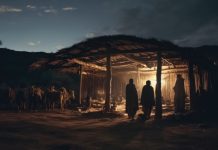Hendel Butoy was born in Brazil and raised in southern California. He studied at the California Institute of the Arts, and was then offered a position as an animator at Walt Disney in 1979.
For the next 24 years Butoy developed a successful career at the famous animation company. Among other things, he worked on creating an episode of the Fantasia 2000 series and the films Rescuers Down Under and The Fox and the Hound.
In 2003, Butoy accepted the invitation to teach animation classes at the School of Visual Art and Design at Southern Adventist University. Hendel Butoy is married to Menjette Jumaud Butoy and they have two teenage girls, Jedel Faith and Cindy Grace. As one can infer from the names he gave his daughters, Butoy speaks openly and passionately about his God. His life story is, at times, reminiscent of the fantastic beauty of the animated tales he worked on for more than two decades.
I came across your name for the first time when I was preparing to come to Southern University to shoot for the TV show “Starting Point.” Although the name is not written as one would write it in Romanian, I was told that yours is, without a doubt, a Romanian name.
Your guess is correct. My family name is Romanian. My father comes from Romania. He left the country under dramatic circumstances, at the beginning of the communist regime, and ended up in Brazil where he married a girl whose parents had come from Hungary and Transylvania, and I was born there. Then they had two more children and thought about emigrating to the US. We came here at the beginning of the 60s.
What was your first contact with image?
I remember receiving Arthur Maxwell’s books, The Bible Story. My father was very good at telling stories. The stories he would tell us for bedtime came from the Bible and he told them in such a dramatic way that I felt I was actually living them. If the story was about David and Goliath, he played the role of David or that of Goliath. When I received these books, I found in them the same stories my father told me. I was interested in the images because they told the story in a different way. This is how I came to be interested in this field: it touched my heart. I then began to want to draw these pictures. I would take a pencil and start drawing.
How old were you when you first took an interest in drawing?
Four or five years old. The drawings were not of good quality. They were a child’s drawings. I was not a genius born with a pencil in my hand, but I liked to draw because I was living the events as I put them on paper.
Did you chose to study painting or animation later?
My father had a video camera he had bought when he was preparing to return to Romania, in 1970. The camera could shoot frame by frame and it made me think of moving images. It sparked my interest for animation. I had seen animations. My parents brought us to see a movie. When I saw that Disney movie, I knew that the event was not real. However, because the images were coming alive and made things seem real, I then realized how powerful the screen was. I saw drawn animals talk. That seemed so real and I thought to myself: This is amazing!
I think this is how it’s going to be in heaven when we will be able to communicate with nature more than we do now.
This is how I realized that I would like to be able to do something similar, to offer others the same feeling I had, that there is something better than this world can offer. Disney movies are just interesting stories but they do not go into the spiritual aspect of things. I would have liked someone to make a movie that goes beyond the story. This, however, did not happen.
When I was 12, I decided I wanted to do what others haven’t done. My father was a bit reluctant to my idea but he enrolled me in a correspondence art school: I would send my drawings, they would evaluate them and send them back with feedback. The course was not cheap and my father did not have a very well-paid job. Nevertheless, he invested in this course and encouraged me.
When I was about to graduate from high school, I learned of a Seventh-day Adventist Christian who attended the California Institute of the Arts (the art school set up at Walt Disney’s wish), within an animation study program. I signed up, but had to work for a year to earn money for my tuition. Disney wanted to train people to come and work for them. Their artists were starting to retire so they wished to shape new ones to take their place.
Many of the Disney artists would mentor the students. At the end of each year, Disney would send some of the artists to observe the students, evaluate their work and see the level they had reached. Excellent students were hired on the spot. I was in the right place at the right time. I was working for a final project when the people from Disney Studio saw what I was doing and asked me to come and work for them. I saw it as an open door. God was telling me: “Go ahead. Use the opportunity.” And so I did.
When we watch movies, we are changed while we watch. Movies are not bad in and of themselves, but we must be very careful and choose wisely what we let our minds feed on.
God had told me to go that way. I chose this way with a lot of prayer because I realized it was an unusual career. I knew that in the movie industry, fiction and stories draw one’s attention but also give suggestions on how to live your life, how to talk, how to relate to others. When we watch movies, we are changed while we watch. Movies are not bad in and of themselves, but we must be very careful and choose wisely what we let our minds feed on.
I was aware that, going into this field, I was not going towards something that would strengthen my faith experience. So I had to be sure that this was the place God wanted me to be. While I was at the art institute, I prayed continuously: “Lord, You know my heart’s desire, but I do not wish to choose this path if You do not open this door for me. If the door is open I will go forward but I do not want to override your principles or my conscience.”
At the Art Institute I worked with many of the people who are now running the company. I asked God to give me opportunities to gain experience and use it to, at some point, manage to convey that there is something beyond this world. While I was there I never had to ask for a raise or another position in the company. They were the ones who always came to me. I was happy to have a pencil and be able to draw. I believe this grateful attitude, and the fact that I let God run things, led me to do what I did and have the responsibilities I had. I worked as an animator, then as the animators’ coordinator, then as a director for two movies and a project for the Walt Disney Park.
How long did you work there and what were the greatest joys you experienced?
I worked there for 24 years. I worked on nine different movies, having different responsibilities. I had two great satisfactions. First, I was doing what I always wanted to do. I couldn’t be happier than that. This is what I wanted to do since I was 12. The second came when I finished something and someone would look at what I did and smile or react in a certain way—crying, or expressing their emotions. I was sitting in front of the screen and instead of watching the movie, I watched the spectators. I followed their emotional answer to what I created.
Did you also have to deal with frustrations?
I dealt with the frustrations any developing artist would experience, but I also experienced a Christian’s frustrations. Being an artist and being a Christian are things that go hand in hand. The frustration a Christian experiences in a place like that is that he cannot always express his faith. You cannot say what you believe. You might be allowed to do so to a certain extent, but indirectly. It’s something that cannot be said openly. This company sells their production to a huge audience. Walt Disney is a business, so the leaders think about the things that will bring profit. They were open and listened to ideas regarding biblical themes but never wanted to make something which was outright Christian. I was treated very well while I was there. My faith was respected. I did not work on the Sabbath, as I had made this request from the beginning. It was actually mentioned in my contract.
I once went on a business trip. I was flying from Europe to the US. I was with Roy Disney. He was so kind to land his plane in Spain so that I would be able to go to church on the Sabbath.
If they liked you as an artist and wanted to keep you there, they respected you, but they did not want religion, your faith, to influence your production too much. But when you’re a Christian you cannot help yourself. You want to be able to express what you are.
So you tried to communicate values and faith in an appropriate manner. Can you give us an example?
I believe the most obvious example is Fantasia 2000. I produced an episode called “Pines of Rome”. The music is written by Ottorino Respighi. Fantasia is a movie where we had to create events that would fit a certain musical piece, so that the two seem one, so that one has the impression that the music was written for that respective story. This was the challenge.
We would listen to these extraordinary musical pieces, close our eyes and use our imagination. The music was so powerful that it made you want to fly somewhere, get somewhere.
The idea that crossed my mind was that, some day, we will fly to other worlds and visit galaxies that God created. I did not say this directly to my team. I just said: “Let’s make something related to flying.” Everybody likes to fly. We sometimes dream of flying. So we made some sketches. Someone drew a whale in the clouds. I’ve never seen something like this, I thought to myself. It is a fantasy. I worked at a story and I thought: What makes these whales to fly? Why do they fly? I started thinking of the things that make us remarkable.
The Bible tells us we have nothing good, valuable in us. We do extraordinary things because God’s Spirit is in us and helps us do these things we would otherwise not be capable of. His presence and His light make us extraordinary. Well, I thought, how could I show these things? Whales do something extraordinary but it does not come from within them, it’s not a power they have. It’s something that comes from outside. What can this thing be? The Bible says: “Every good and perfect gift is from above, coming down from the Father of the heavenly lights.” So I drew the light somewhere up there, in the air, and then the Nova star. It illuminates more and more and then the whales start flying! It is a subtle thing. Not many people perceive it like that. However, I know it and if people ask me about it, I tell them. And whales do more than just fly: they go higher and higher until they cross over, into another space, which is another Christian idea.
I saw the movie and was overwhelmed with emotion. I was very touched by the images and loved the music. I knew it for some time but still it was unexpected to see it begin with the Pines of Rome and end with the flying whales. It was impressive.
People used to say that animations are for children, but not anymore. Is it okay to allow children to watch the animations that are currently screened? If so, what are the good things? If it isn’t, why not?
I think my answer is: it depends. Like a good painting or a piece of art that can talk to us, have a message, animation is a means of communication. It was used first and foremost for children, because they are attracted to colours and drawings. Movies and animations have a lasting impact. They thus have power. It depends what kind of impact they have. Movie creators are responsible for this. If what is left behind is God’s beauty, it’s extraordinary, it is a valuable thing.
A person who sees Christ in a character, or in the way others are treated, can be encouraged to love Him more.
We can also convey other philosophies and life ideas. And, I believe, this is what is happening: if the film producer or the animator does not know God, what they do will not reflect Him.
And if God is not there, then other things, other thoughts will be present there. There are Christians who sometimes come up to me and ask me: “You worked for Disney? Is that not the place that produces spiritist movies that are not good for our children?” I then answer: “Yes, they produce such movies, but do not do it deliberately.” I was there, at their meetings. They don’t say: “Let’s put something spiritist in here.” What they do is not place God there. They want to be secular. They don’t want to do anything that has the slightest religious tint, that would represent God. So they exclude these things. If we exclude God from stories that focus on what is beyond us, what is there left? Only spiritism. They are not trying to include these things. It’s just that they leave God out of it.
If the movie producer is a devoted Christian and seeks for God’s guidance to know how he can best talk about God’s love, if God gave him a talent, I believe He uses any means, including animation, to communicate with people through that artist, through that movie.
Because in that case, it’s not what the artist says that matters but the fact that God communicates through that means, through the artist.
A good example in the Bible is the moment when God told Moses that He chose two artists to communicate His salvation plan through the decorations in the Tent of Meeting. It was the first time that God wanted to communicate His salvation plan. And for that He chose artists. The Bible says: “I have filled him with the Spirit of God, with wisdom, with understanding, with knowledge and with all kinds of skills.” If an artist dedicates himself to the Lord, whether he is an animator, musician, or writer, if he is filled with the Holy Spirit, the Spirit will help him make things that will reflect His character so that, through him, God would influence people’s lives. I believe animation can do that and it is my heart’s desire to see this happening.
It seems like you have a certain project in mind when you say this. Will you share it with us?
Yes. It is the project The Life of Christ. Because I am a Christian, Jesus Christ is the person I want to talk about the most. When I read of His life, especially in Ellen White’s book, Desire of Ages, in which Jesus’ story comes alive, I say to myself: “I would like to be able to draw it so that others may see it.” Perhaps they don’t want to read the book. However, if they see it they might be drawn to the Bible and might want to get to know Him better.
I have wanted to illustrate Jesus’ life since I was working at Disney. When Southern University called me, I thought: Perhaps this is an opportunity to not only teach students but also to prepare some of them to be part of such a project. You can see part of this project on the internet.
It’s not an easily applicable project and I do not want to make it superficially, just for the sake of it. I want one to be able to feel God’s power there. I want the Holy Spirit to work and talk through the artist. It’s one of the most difficult projects I have been working at. Yet, at the same time, it is what brings me joy, because I am doing exactly what I have always wanted to do.
I am a Christian. I believe in Christ. I have been given a talent, and I am using it.
I couldn’t be any happier. All those 24 years working for Disney cannot compare with working for something I strongly believe in and want to express. We must use all possible means to paint a beautiful image of Jesus, that touches people’s hearts and that makes them wonder: “Was He truly the Son of God? I want to know more about Him,” and then go to the Bible.



















